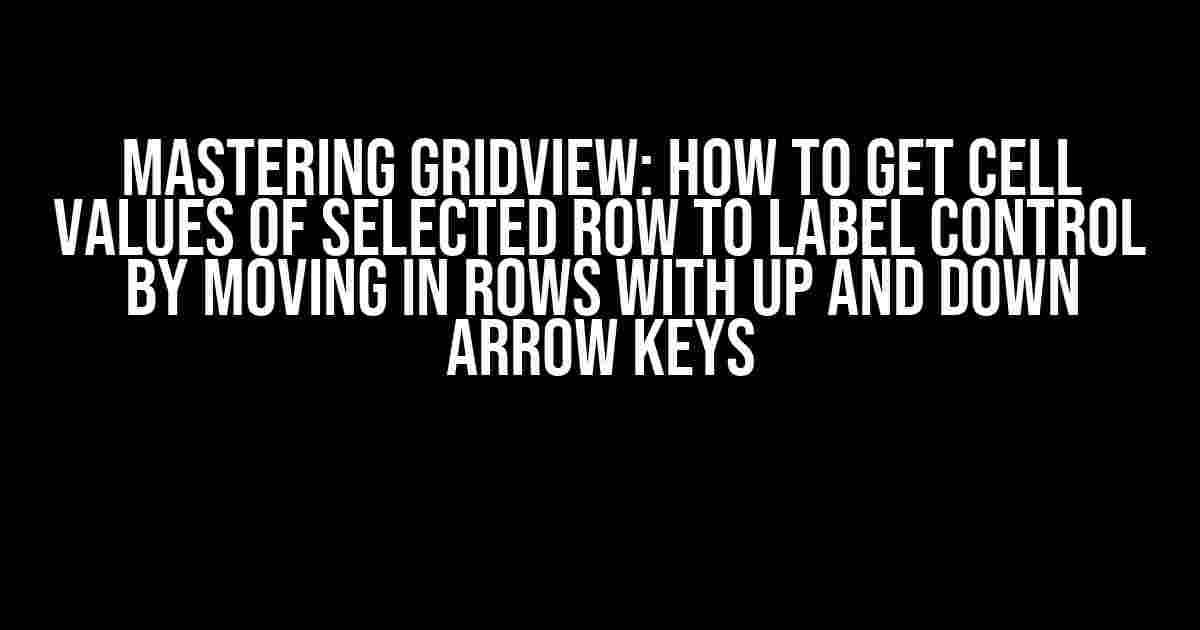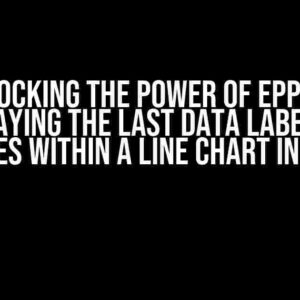Are you tired of manually selecting rows in your GridView to retrieve cell values and display them in a label control? Do you wish there was a more efficient way to achieve this using the up and down arrow keys? Well, you’re in luck! In this article, we’ll explore the simplest and most effective way to get cell values of a selected row to a label control by moving in rows with up and down arrow keys.
Why is this important?
In many applications, GridViews are used to display large amounts of data, and users often need to navigate through the data quickly and efficiently. By allowing users to move through the rows using the up and down arrow keys, you can provide a better user experience and increase productivity. Moreover, retrieving cell values of a selected row and displaying them in a label control can be a crucial step in many business logic scenarios.
Step-by-Step Instructions
Follow these easy steps to get cell values of a selected row to a label control by moving in rows with up and down arrow keys:
-
Create a new ASP.NET web application project in Visual Studio.
-
Drag and drop a GridView control from the toolbox onto your web form.
-
Add columns to your GridView as needed. For this example, let’s assume we have three columns: ID, Name, and Age.
-
Add a Label control below the GridView to display the selected row’s cell values.
-
In the GridView’s RowDataBound event, add the following code:
<code> protected void GridView1_RowDataBound(object sender, GridViewRowEventArgs e) { if (e.Row.RowType == DataControlRowType.DataRow) { e.Row.Attributes.Add("onmouseover", "JavaScript:MouseOver(this)"); e.Row.Attributes.Add("onmouseout", "JavaScript:MouseOut(this)"); } } </code>This code adds mouseover and mouseout events to each row in the GridView.
-
In the JavaScript section, add the following code:
<code> <script type="text/javascript"> var selectedRow = null; function MouseOver(row) { if (selectedRow != null) { selectedRow.style.backgroundColor = ""; } row.style.backgroundColor = "#C2D6F5"; selectedRow = row; } function MouseOut(row) { row.style.backgroundColor = ""; } function GetSelectedRowCellValue(cellIndex) { if (selectedRow != null) { return selectedRow.cells[cellIndex].innerHTML; } return ""; } </script> </code>This code defines three JavaScript functions: MouseOver, MouseOut, and GetSelectedRowCellValue. The MouseOver function sets the background color of the selected row, while the MouseOut function resets the background color. The GetSelectedRowCellValue function returns the cell value of the selected row based on the provided cell index.
-
In the GridView’s KeyDown event, add the following code:
<code> protected void GridView1_KeyDown(object sender,GridViewCommandEventArgs e) { if (e.CommandArgument.ToString() == "Select") { int rowIndex = int.Parse(e.CommandArgument.ToString()); GridViewRow selectedRow = GridView1.Rows[rowIndex]; Label1.Text = "ID: " + GetCellValue(selectedRow, 0) + "<br/>Name: " + GetCellValue(selectedRow, 1) + "<br/>Age: " + GetCellValue(selectedRow, 2); } } private string GetCellValue(GridViewRow row, int cellIndex) { return row.Cells[cellIndex].Text; } </code>This code handles the KeyDown event of the GridView. When the up or down arrow key is pressed, it retrieves the selected row index and gets the cell values using the GetCellValue function. Finally, it updates the Label control with the retrieved cell values.
-
Run the application and test it by pressing the up and down arrow keys to navigate through the rows in the GridView. As you move through the rows, the Label control should display the corresponding cell values.
Why does this solution work?
This solution works because we’re leveraging the RowDataBound event to add mouseover and mouseout events to each row in the GridView. This allows us to track the selected row and retrieve its cell values using JavaScript. The KeyDown event is then used to handle the up and down arrow key presses, and the GetCellValue function retrieves the cell values based on the selected row index.
Common Issues and Solutions
Here are some common issues you might encounter when implementing this solution:
-
Issue: The Label control is not updating with the correct cell values.
Solution: Ensure that the GridView’s KeyDown event is properly wired up and that the GetCellValue function is correctly retrieving the cell values.
-
Issue: The mouseover and mouseout events are not working correctly.
Solution: Verify that the RowDataBound event is properly adding the mouseover and mouseout attributes to each row in the GridView.
-
Issue: The application is slow or unresponsive when navigating through the rows.
Solution: Optimize your GridView by using paging, caching, or other performance-enhancing techniques to reduce the load on your application.
Conclusion
In this article, we’ve demonstrated a simple yet effective way to get cell values of a selected row to a label control by moving in rows with up and down arrow keys. By leveraging JavaScript and the GridView’s events, we can provide a seamless user experience and increase productivity. Remember to test and optimize your solution to ensure it works smoothly and efficiently.
| GridView Event | Description |
|---|---|
| RowDataBound | Fired when a row is data-bound to the GridView. |
| KeyDown | Fired when a key is pressed while the GridView has focus. |
By mastering the GridView and its events, you can create powerful and efficient applications that meet your users’ needs. Happy coding!
Frequently Asked Question
Get ready to navigate your way through the world of Datagrids and Label controls with the help of these FAQs!
Q: How can I get the cell values of the selected row in a Datagrid and display them in a Label control?
A: To achieve this, you can use the SelectedIndexChanged event of the Datagrid and retrieve the selected row’s values using the CurrentRow property. Then, you can assign these values to the Text property of the Label control.
Q: What event should I use to capture the up and down arrow key presses in the Datagrid?
A: You can use the KeyDown event of the Datagrid to capture the up and down arrow key presses. In this event, you can check the KeyCode property to determine whether the up or down arrow key was pressed.
Q: How do I move to the previous or next row in the Datagrid using the up and down arrow keys?
A: You can use the MoveCurrentCell method of the Datagrid to move to the previous or next row. This method takes a boolean parameter indicating whether to move to the previous or next cell. Use this method in conjunction with the KeyDown event to move to the previous or next row based on the arrow key pressed.
Q: What’s the best way to update the Label control with the new cell values when the selection changes?
A: You can update the Label control in the SelectedIndexChanged event of the Datagrid. This event is triggered whenever the selection changes, allowing you to retrieve the new cell values and update the Label control accordingly.
Q: Is there a way to prevent the Label control from updating unnecessarily when the user presses the up or down arrow keys?
A: Yes! You can set a flag in the KeyDown event to indicate that the selection has changed due to an arrow key press. Then, in the SelectedIndexChanged event, you can check this flag and only update the Label control if it’s not set. This ensures that the Label control only updates when the selection changes, not when the user presses the arrow keys.


